 |
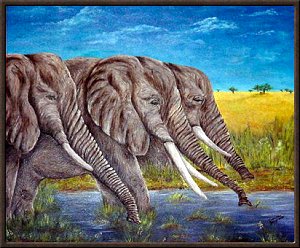 This elephant painting is one I did a few years ago. And though you can't see it here, there is a small lion resting in the shade of the closest tree. |
|
|
|
RECENT ELEPHANT NEWS: Once again at CITES (Convention on the International Trade in Endangered Species) meeting in Chile in November 2002, there is a proposal seeking permission for ivory sales to go ahead, and for approval to trade in live elephants, elephant skin and hunting trophies. The proposals are from the pro-trade leader Zimbabwe, with Namibia, Botswana, South Africa and Zambia too. This would turn the clock back to the late 1980's when up to 200 elephants a day were being killed for their ivory. The global ivory ban, passed by CITES in 1989, led to a decline in poaching that saw the value of illegal ivory plummeted to less than $20.00 a kilo from the pre-ban price of up to $300.00 a kilo. With the increasing human population and loss of habitat for elephants, this proposal could very well push the African Elephant periliously close to extinction. What YOU can do to help: 1. The Born Free Foundation has set up a page to inform you what you can do to help as well as having a petition to sign that will be presented at CITES by 2 of their representatives. 2. The USA is a member of CITES, so let them know how you feel. You could write your representatives, senators, the US Fish and Wildlife Service, or the Secretary of the Interior. My thoughts on this: I know those countries do not want anyone telling them what they can do with what they consider their "natural resources", BUT I don't think they have the right to use living creatures like elephants in that manner. At the very least, they could "use them up". Then what would they have? If you try to develop a tourist industry for wild animal viewing, what happens if you let all the animals get killed? Who would ever want to visit their country then? Not me.  General Elephant InformationElephants are the largest and heaviest living land animals. Their noses, gestation period, front teeth - and maybe even their memory - are the longest in the animal kingdom. They and their extinct relatives have lived everywhere except Australia and Antarctica, from sea level to heights of more than 12,000 feet, in habitats ranging from deserts to rainforests to glaciers. In fact, if it were not for humans, elephants would probably rate among the most successful species on Earth. The elephant family is made up of the African (Loxadonta Africana) and the Asian (Elephas Maximus) elephant. Though there is a recognized subspecies of the African, known as the Forest (Loxadonta Africana Cyclotis) elephant found in the rainforests of the African continent. They represent the topmost branches of an amazing family tree, the other branches of which have all died out. The zoological family Elephantidae, or true elephants, contains at least 26 species. This family is part of a larger group, of more than 160 related species, called the order Proboscidea - meaning animals with a proboscis or trunk. Though elephants are known as pachyderms, this actually refers to "thick skin" and also includes other animals - the rhinoceros, the hippopotamus, and the tapir.
In elephant society, family herds are led by an old grandmother known as the matriarch. She is the dominant female, and the herd she is in charge of will probably consist of her sisters, daughters, female cousins, and their young offspring. A typical herd consists of 20 to 40 females (cows) of all ages. Only nursing and immature malesremain with the herd. Because elephants live to such a great age - possibly as long as 70 years - their social ties last for decades. A large herd can be divided up into a subgroup of 3 to 6 elephants. These are basic units of elephant society, usually made up of a mother and her calves, perhaps staying close to her sister and her sister's offspring. Adult males (bulls) usually live alone or in small groups of up to seven members. Male elephants leave the herd by their mid-teens, where they begin the long, slow climb up the male ladder of success, with the biggest, strongest bulls in the area at the top. Males show little interest in their offspring; instead, they stay out of the family herd and concentrate on keeping their status among the males in their population. 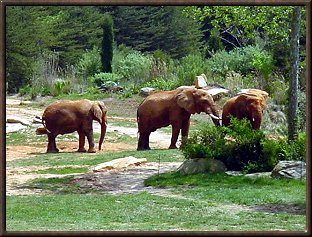
Elephants are active during the day and at night, normally resting in the hottest part of the day. Toward sundown, the herd moves toward water to drink and bathe. Elephants normally drink at least once a day. After drinking, they may stay in or near the water for some time. Not only do they drink and bathe, they trunk-spray their own and each other's bodies, they splash and churn up the mud, and they roll over and squirm, giving every indication of having a good time. Thick, sticky mud is highly favored, and after a roll, calves emerge looking like chocolate-covered elephants. Elephants are generally peaceful and easygoing, and they show great affection for one another. They even communicate with each other in many ways and with all their senses. They rely less on their eyes than humans do, but visual signals are important - the position of their ears and trunk shows what mood an elephant is in. Their sense of smell can tell them something about another elephant's health. Touch can also be used to convey some information. But the main way an elephant communicates deliberately is, as with humans, by sound. Elephant vocalizations range from high-pitched squeaks to deep rumbles. These deep rumbles, as much as two thirds of what an elephant is saying, are too low for the human ear to detect. The saying "an elephant never forgets" is close to the truth. Elephants do have a remarkable memory. In the wild, elephants appear to remember for years their relationships with dozens, perhaps hundreds, of other elephants, some of whom they may only see occasionally. The advantages of a good memory may explain why they have evolved such a large brain. 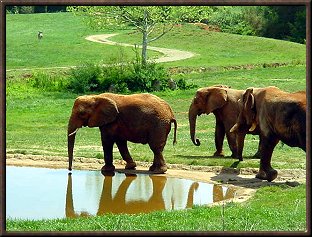
Elephants are described by ecologists as "keystone species". Ecology is the science concerned with ecosystems, the ways in which animals and plants interact with each other and with their environment. Elephants play such an important role in their ecosystem that, the loss of elephants from an area would cause the existing ecosystem to collapse. Many species of animals and plants, in both Africa and Asia, benefit from the presence of elephants. Some of these species could not survive without them. When conservationists try to protect elephants, their work has a wider aim as well - to save the whole ecosystem and preserve biodiversity. And if elephants are to survive, we must make sure that two things happen: first, enough elephant habitat must be left in its natural state, and secondly, the elephants must be protected. This can come about by legislation and the efforts of conservation societies such as the ones listed below in the "further information" list. As well as education on every level, so that everyone learns to share the environment to the benefit of us all.  Elephant News and ResearchAs of January 8, 2002, the President of the USA has signed into law the African Elephant Conservation Reauthorization Act. This new law will further the USA's national interest in promoting environmental stewardship around the world. This law will provide important grants to help conserve some of the world's most critically endangered species through public-private international partnerships that deliver on-the-ground conservation projects and build local conservation expertise and capability. 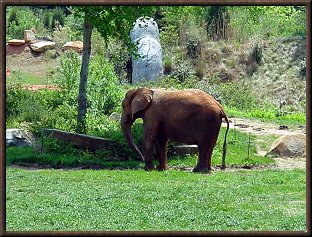
Elephant relocation seems to be becoming more common. Instead of culling more than 1,000 elephants located in South Africa’s Kruger National Park, the elephants are to be spared by plans to transport the animals to a new game reserve in neighbouring Mozambique. The operation will see about 1,100 elephant bulls, cows and calves transported by lorry across the South African border, in a multimillion-pound exercise expected to take several years. Former South Africa president, Nelson Mandela, formally opened the gates to the neighboring countries for the transportation of the first 40 elephants. This new park, known as "Great Limpopo Park", has 13,510 square-miles in the countries of South Africa, Mozambique, and Zimbabwe. According to Crispian Olver, director-general of South Africa's Department of Environmental Affairs and Tourism, it is probably the single most important event in conservation in this century for South Africa and the region. This park will open natural migratory routes, which were artificially blocked by political boundaries constructed by the colonial masters of southern Africa, and will reestablish the herds that once roamed freely. The park will be governed by an international treaty which will be signed by the ministers of environment from the three countries. And I would love to see cooperation on this grand scale to spread throughout the world! What are the long term effects of poaching on an elephant population? Charles and Lara Foley are studying the elephant population in Tarangire National Park in Tanzania to find out some answers to this question. Since poachers seek out the largest tusks, and since the tusk grow on an elephant throughout its lifespan, the oldest and most experienced elephants are killed first. The result is not only a decline in the overall elephant population, but a severely impacted social structure. Elephant society is matriarch-led and the matriarch is usually the oldest female, who by longevity has experiences with droughts and hardships, and have learned from their grandmothers where the best places to find food and water are located. But what happens when all the mature elephants have been poached? In Tarangire, which had a long drought that lasted from 1992 to 1994, some groups of elephants with older matriarchs left the park to find other sources of food and water, but some groups with young (in their twenties) matriarchs stayed because they had no knowledge of where to go to find water or food. These groups suffered poor physical condition, low birthrates, and high infant mortality. All as a result of poaching. Tarangire has since had better conditions and is one of the best places in Africa to see large herds of elephants. But it will take many years for populations to build up experiences to overcome the poaching of older elephants. 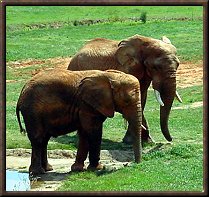  Elephant Sanctuaries and OrganizationsOne very special place that is trying to do so much for "retired" Asian elephants as well as elephants in general is "The Elephant Sanctuary" in Hohenwald, Tennessee. They are providing a great life for elephants that have become a burden to their former owners, by becoming too old to breed, to old to perform, or difficult because the elephant decided to behave like an elephant. This place has acres and acres for their elephants to roam. They have doctored elephants that need medical help, fed the undernourished elephants, and most importantly, given the elephants a chance and place to be as elephants will naturally be - together in a safe environment. Please visit and read all about this place and at least let them know you care too! The "Living With Elephants Foundation" of Botswana is a registered non-profit organization in Botswana that is dedicated to relieving the conflict between humans and elephants. They try to resolve the day-to-day problems by using educational programs which encourage a harmonious relationship between elephants and people. Since Botswana has the largest remaining free range African Elephant population of any of the range states, there is a lot at stake. Please check out their organization for more information and to see how you can get involved!  Elephant Books
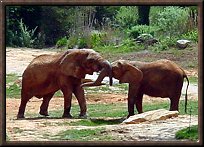  Further Information
Other Links at Nature Haven A Midsummer Night's Dream | Awards and Webrings | The Bird's Nest | Birds of Fall | Birds Of Spring | Birds Of Summer | Birds Of Winter | Bison | Black Bears | Botanicals | Butterflies and Moths | Caecilians | Caribbean Amphibian | Chipmunks | Cottontail Rabbits | Cougars | Dolphins | Elephants | Flamingos | Frogs | Home | Hummingbirds | In The Garden | Joyous Spring | Manatees | Moo's Holstein Paradise | My Backyard Bird Count Statistics | Nature News | Ocean Dreams | Pictures | Poetry | Salamanders & Newts | Sea Otters | Sea Turtles | Squirrels | Summer | The Library | The Ocean Realm | The Parrot Republic | The Pond | Tigers | Toads | Wildlife of Western North Carolina Site Map Email at: dh @ naturehaven.com (Take out the spaces and this email address will work!) Please Read Guestbook ~~~ Please Sign Guestbook |